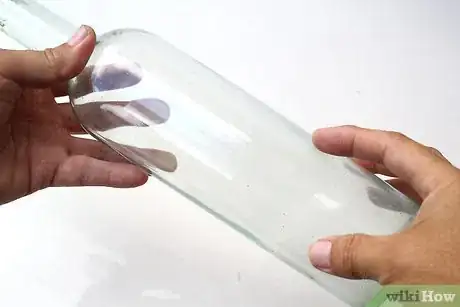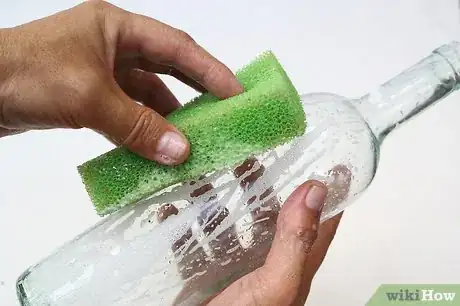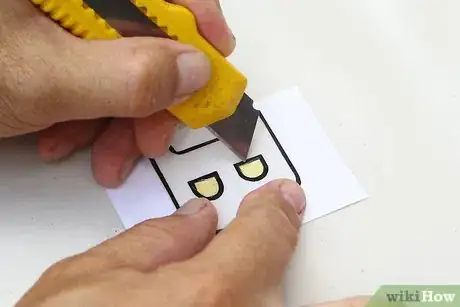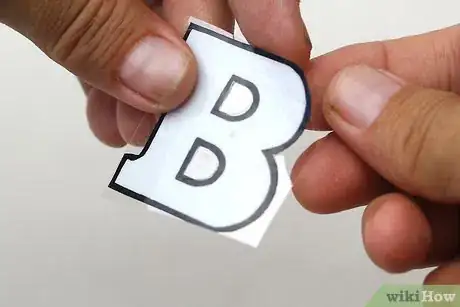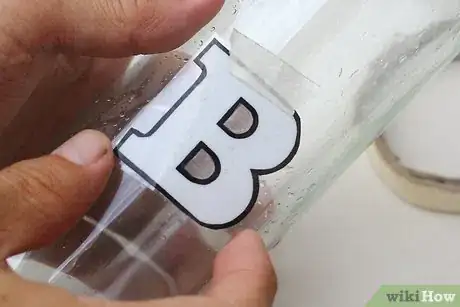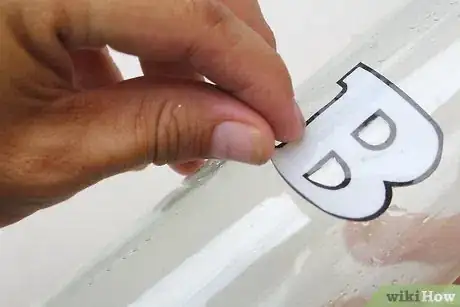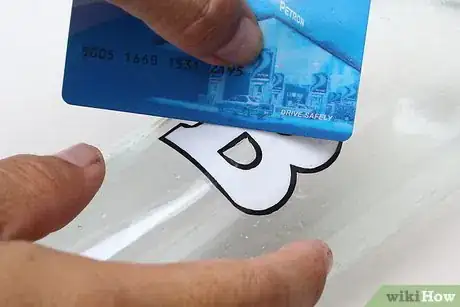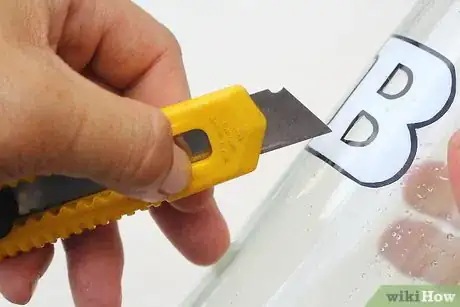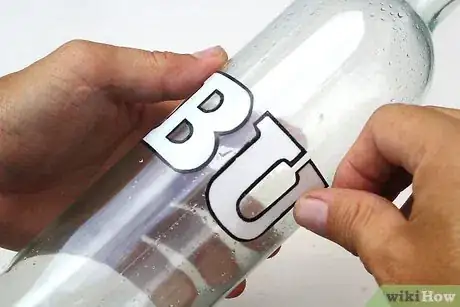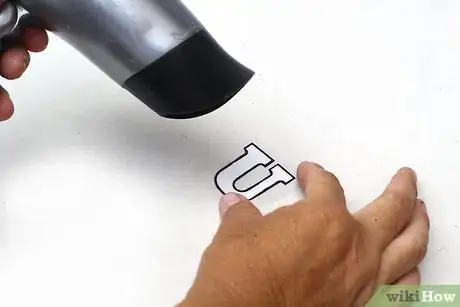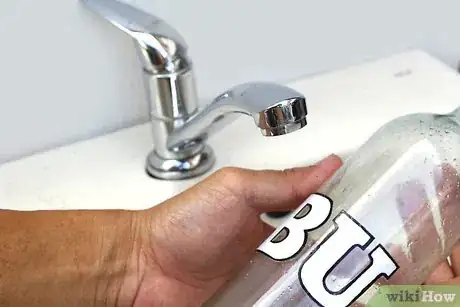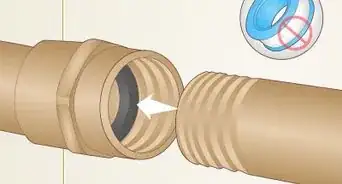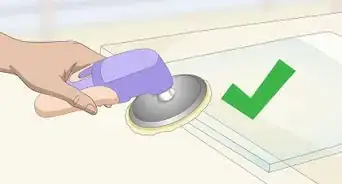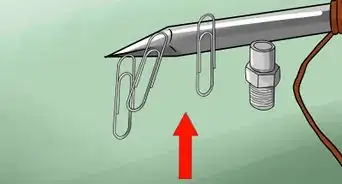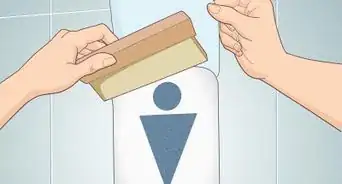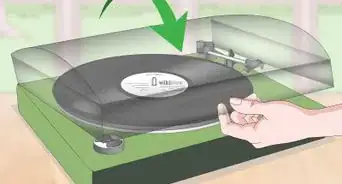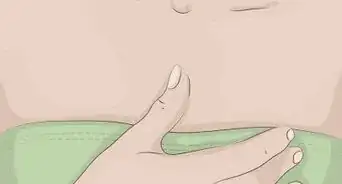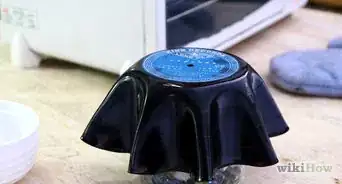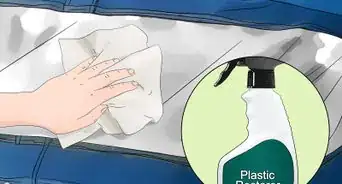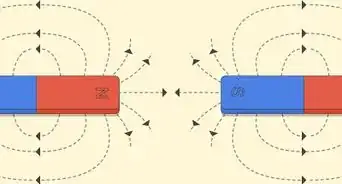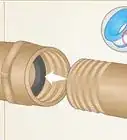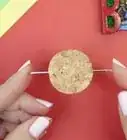This article was co-authored by wikiHow Staff. Our trained team of editors and researchers validate articles for accuracy and comprehensiveness. wikiHow's Content Management Team carefully monitors the work from our editorial staff to ensure that each article is backed by trusted research and meets our high quality standards.
This article has been viewed 17,002 times.
Learn more...
It can be difficult to smoothly attach vinyl designs to curved surfaces, like drinking glasses, vases, or cars. Before applying vinyl, clean the surface it’ll be attached to and mark out your design with tape or a grease pencil. When applying vinyl, hold it in place with a piece of tape so it isn’t attached on an angle, then peel away the adhesive backing and press it onto the surface. Improve vinyl applications by breaking large designs into smaller pieces. Protect your designs by handwashing them.
Steps
Preparing the Surface and Vinyl
-
1Evaluate the surface where the vinyl will be attached. Severely or irregularly curved surfaces will require greater care while applying the vinyl. Surfaces that are dirty may negatively impact the vinyl’s adhesive. Visualize the placement of your vinyl so you have a clear idea where it will go.
-
2Clean and mark the surface. If the surface is dirty, clean it with a suitable cleaning agent. For most surfaces, soap and warm water or an ammonia based cleaner, like most window cleaners, work well. Wipe the surface completely dry after cleaning, then mark the placement of your design with painter’s tape.[1]
- You can substitute another weak adhesive tape, like masking tape, for painter’s tape. Weak adhesive tape will be easier to remove later and isn’t likely to leave behind an adhesive film.[2]
- For a more precise outline, use a grease pencil to draw the placement of your design on the surface. Some surfaces may react negatively to grease pencils. Test pencils on an out of sight area first.
Advertisement -
3Trim excess material from the vinyl. In some cases, you may need to use a utility knife to cut the vinyl so only the design remains on the adhesive backing. Then cut excess vinyl backing from the design with scissors. Leave a small border of adhesive backing around the design.
- If you’re applying vinyl lettering to an item, don’t forget to cut out the empty spaces, like the middle parts of the letters A and O.
- It may be difficult to remove small pieces of vinyl from designs. In these situations, try to lift unneeded pieces of vinyl from their backing with the edge or tip of your utility knife.[3]
-
4Apply transfer tape to the vinyl. Cut a strip of transfer tape or contact paper so it is the same size as the vinyl backing. Peel the adhesive backing from the tape or paper. Starting from one side of the design, use your fingers to apply the tape or paper to the vinyl and its backing a little bit at a time.
- Your tape or paper doesn’t have to be attached to the vinyl and its backing perfectly. Wrinkles and bubbles in the tape or paper shouldn’t transfer to the vinyl design.
- To ensure the tape or paper is firmly attached to the vinyl, press the paper to the vinyl design with your nail using moderate force. You can similarly use a rigid edge to do this, like a credit card.[4]
Applying the Vinyl
-
1Secure the vinyl to the surface with tape. Position your design in place on the surface. When it is in place, use a piece of painter’s tape to attach the vinyl to the surface from top to bottom across its middle. The edges of your design will likely stick out from the curved surface to the left and right of the tape.[5]
- This step is not absolutely necessary, but the tape will hold the vinyl in place while you apply it, preventing it from being attached unevenly or on an angle.
-
2Peel free and cut away the adhesive backing. Remove the vinyl backing from one side of the design until you reach the tape. Cut away the unattached backing. Press the vinyl design into place on the surface. Remove the tape and repeat the process on the opposite side.[6]
- When pressing your vinyl into place, do so a little bit at a time. Start from the edge closest to the tape and work your way to the outside of the design. This will prevent bubbling and wrinkles.
- It may help to hold the vinyl lightly taut as you press it onto the surface. This can stretch the vinyl so it better covers severe curves in the surface.[7]
-
3Remove bubbles and wrinkles with your fingernail or a rigid edged item. Even careful applications of vinyl sometimes have wrinkles or air bubbles. Use your nail or a rigid edged tool, like a credit card, to push wrinkles and bubbles out of the edges of the design.[8]
- Some bubbles may resist your efforts at removal. In these situations, you may have to remove and reapply the vinyl, or you could pop the bubble with a pin and try to smooth it.
-
4Slit severe wrinkles to redistribute the vinyl. Severe wrinkles won’t likely be affected by the nail/credit card technique. To correct this problem, make a small slit in the wrinkled vinyl. Pull the vinyl to remove the wrinkle and reattach it so the excess material overlaps the surrounding vinyl.
- While overlapping vinyl may be obvious when closely inspected, it’ll likely be less obvious than the severe wrinkling.[9]
Improving and Protecting Vinyl Applications
-
1Prioritize small pieces of vinyl for easier installation. Generally, smaller designs attach most easily to surfaces. In some cases, you may be able to cut up larger designs into smaller pieces. These pieces can then be attached on the surface one at a time to complete the larger design.[10]
-
2Heat vinyl to loosen its glue and reposition it when necessary. This technique is especially useful for stubborn wrinkling or bubbling around the edges of your design. Lightly heat the vinyl with a hairdryer or heat gun. Peel up the vinyl and pull it lightly to remove wrinkles, then press it back into place.
- Some vinyl may be difficult to peel away even when heated. Use the tip or edge of your utility knife to carefully lift the design if necessary. Be careful not to damage the surface the vinyl is attached to.[11]
-
3Wash items with vinyl by hand. The heat and water pressure of dishwashers may harm vinyl designs and cause them to peel. Prevent this from happening by washing all items with vinyl with mild soap and warm water. Hand dry items with a dishtowel to prevent streaking before putting them away.[12]
Warnings
- Always use tools, like utility knives and scissors, with care. Improper usage could cause injury, damage to your design, and/or damage to the surface to which the vinyl is being applied.⧼thumbs_response⧽
Things You’ll Need
- Painter’s tape (or similar, weak adhesive tape, like masking tape)
- Rigid plastic credit card (or a similar item; for pushing out air bubbles)
- Scissors
- Transfer tape (or contact paper)
- Utility knife
- Vinyl design
References
- ↑ http://www.signindustry.com/installation/articles/2006-01-31-JL-VinylOverCurvesMoldingNmore.php3
- ↑ https://www.youtube.com/watch?v=OSFZaC_cjZs
- ↑ https://www.youtube.com/watch?v=JUtIqw0CZh8
- ↑ https://www.youtube.com/watch?v=JUtIqw0CZh8
- ↑ https://www.youtube.com/watch?v=OSFZaC_cjZs
- ↑ https://www.youtube.com/watch?v=JUtIqw0CZh8
- ↑ http://www.signindustry.com/installation/articles/2006-01-31-JL-VinylOverCurvesMoldingNmore.php3
- ↑ https://www.youtube.com/watch?v=JUtIqw0CZh8
- ↑ http://www.signindustry.com/installation/articles/2006-01-31-JL-VinylOverCurvesMoldingNmore.php3
